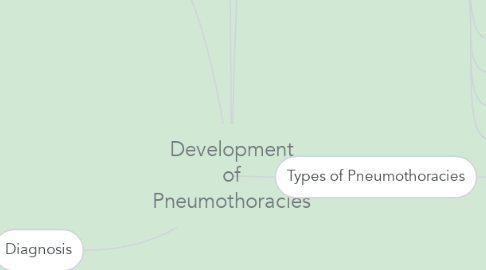
1. Predispositions
1.1. Age < or >
1.2. Gender
1.3. Socioeconomic status
1.4. Environment
1.5. Genetics / Family Hx
1.6. Immunisation status
1.7. Pre-existing acute or chronic lung pathology
2. Diagnosis
2.1. Signs & Symptoms
2.1.1. SOB/Dyspnoea
2.1.2. Chest pain
2.1.3. Cough
2.1.4. Fatigue
2.1.5. Increased Respiratory rate
2.1.6. Increased heart rate
2.1.7. Unequal air entry
2.1.8. Chest wall asymmetry
2.1.9. Low blood pressure (tension)
2.1.10. Abnormal posturing
2.1.11. Increased JVP
2.1.12. Use of accessory muscles
2.2. X-Ray
2.3. Arterial Blood Gas Analysis
3. Treatment / Management
3.1. Finger/needle thoracostomy
3.2. Chest drain
3.3. Symptom management
3.4. Rule out other cause
3.4.1. Ischaemic Heart disease
3.4.2. Pulmonary embolism
3.4.3. Acute pulmonary oedema
3.4.4. Asthma
3.4.5. Lung infection
3.4.6. Cardiac tamponade
3.4.7. Fractured ribs
4. Eitiology
4.1. Trauma
4.1.1. Blunt
4.1.1.1. MVA
4.1.1.2. Assault
4.1.1.3. Fall from height
4.1.2. Penetrating
4.1.2.1. Gunshot
4.1.2.2. Stab
4.1.2.3. Impalling
4.1.3. Explosive
4.2. Spontaneous
4.2.1. Chronic/Acute lung pathology
4.2.1.1. COPD
4.2.1.2. Asthma
4.2.1.3. Cystic Fibrosis
4.2.1.4. Lung infection (i.e. pneumonia, tuberculosis)
4.2.1.5. Connective tissue disorder (i.e. Marfan's syndrome)
4.2.1.6. Lung cancer
4.2.2. Smoking
4.2.3. Force creating pressure difference i.e. coughing
4.2.4. Genetic predisposition
4.2.5. Catamenial
